
The CoJMC is offering unique new pop-up courses for spring 2020. Learn more about dates and times for each class at https://journalism.unl.edu/pop-up. Classes include:
Creative Problem Solving by Archrival
Perhaps there is no greater skill than creative problem solving. Learn how to take a challenge and turn it into an opportunity through strategy, critical thinking and creative passion. After a series of quick hits, we'll work on a real project and take you through the Archrival school of hard knocks. Briefs. Insights. Strategy. Execution. Presentation. At the end of an intense two weeks, you'll have to pull it all together into a final pitch for a panel of judges. Good luck with that and be prepared to bring your A game.
Faculty: Clint! Runge, founder and CEO, Archrival
History of Women in Advertising, Broadcasting, Journalism and Sports
The course will discuss the history of women in advertising, broadcasting, sports, and journalism. While students may have some knowledge of women in these professions, this course will dive in deeper to the history of women in the profession especially those taking leadership roles. Women also played roles far earlier than many of us realize and often failed to receive the full credit due for their roles. The course will include looking at women of color in the professions. The course will answer the questions: Who were the trailblazers? Who had accomplishments many may not know about? How did women in the profession get the ground they have? What can we learn from these women and their contributions?.
Faculty: Katie Krcmarik
360 Video
In traditional video storytelling, it's easy to focus a viewer’s attention in order to further the story: Simply point the camera at the action. Framing excludes any extraneous content. In the 360 video environment, the storyteller can no longer control the frame: the viewer does. How must the story change to accommodate for this? How does a storyteller direct attention without a frame? What types of stories work, and what types do not, in a 360 environment? We will take a practical approach to answering these questions by creating short stories using 360 video.
Faculty: Alan Eno